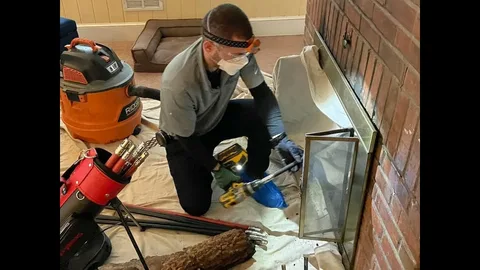How to Inspect and Repair Chimney & Wood Stove Like a Pro
Maintaining your chimney and wood stove in good working condition ensures safety, efficiency, and warm comfort on those chilly winter nights. Here we demonstrate how to inspect & repair chimney & wood stove repair professionally even for a novice. From being aware of the warning signs, to regular inspection, to home repairs, all come under this article.
Why Regular Inspection Matters
Chimney or wood stove upkeep is not offered, leading to creosote buildup, heat loss, smokiness seepage, and chimney fires. A yearly inspection—ideally before winter—will identify issues early on, saving you money and your house less.
Tools & Materials You’ll Need
- First, keep tools on hand:
- Flashlight or headlamp
- Protective gloves and dust mask
- Chimney brush and extension rods
- Drop cloths or tarp
- Screwdriver set
- Wire brush and shop vacuum
- Replacement gaskets or firebricks (optional)
Step 1: Visual Inspection from the Outside
- Check the Chimney Cap and Crown
- Look for cracks, missing mortar, or a loose cap.
- Look for cracks, missing mortar, or a loose cap.
- Inspect the Masonry or Metal
- Ensure bricks, stones, or metal panels are intact with no visible rust or deterioration.
- Ensure bricks, stones, or metal panels are intact with no visible rust or deterioration.
- Look for Obstructions
- Birds’ nests, leaves, or debris can block airflow.
- Birds’ nests, leaves, or debris can block airflow.
Step 2: Inside Chimney Inspection
- Shine light inside to view soot or creosote glaze.
- Mirror if accessible.
- Inspect flue liner for holes or cracks.
Tip: If slicked up with thick, shiny creosote, call a pro.
Step 3: Inspect the Wood Stove
- Door Gaskets
- Close a piece of paper in the door and tug; if it slides out easily, the gasket may need replacing.
- Close a piece of paper in the door and tug; if it slides out easily, the gasket may need replacing.
- Firebricks and Baffle
- Look for cracks or warping.
- Look for cracks or warping.
- Chimney Connector Pipe
- Check for rust or loose joints.
Step 4: Cleaning & Minor Repairs
- Sweep flue with chimney brush of same diameter as your liner.
- Sweep out loose ash and soot.
- Replace loose or broken firebricks or gaskets.
- Tighten screws and seal seams with high-temp sealant, if needed.
Quick Reference Table
| Task | Frequency | Tools Needed | DIY Difficulty |
| Exterior chimney check | Once a year | Ladder, flashlight | Easy |
| Flue creosote cleaning | Once a year | Chimney brush, vacuum | Moderate |
| Wood stove gasket replacement | Every 1–2 years | Screwdriver, replacement gasket | Moderate |
| Firebrick inspection | Every 6 months | Flashlight | Easy |
| Smoke detector battery check | Twice a year | New batteries | Easy |
Safety Precautions Before You Begin
- Allow the stove to cool completely.
- Wear a mask, safety glasses, and gloves.
- Drop cloths cover flooring and furniture.
- A fire extinguisher is kept handy, just in case.
When to Call a Professional
Certain tasks are best left to pros, so have a professional stove technician or chimney fireplace repair call if:
- Rough cracks have formed in the liner or masonry.
- Creosote is fine and shiny (Stage 3).
- Leaks of rust or heavy water occur.
Seasonal Maintenance Calendar
- Spring: Final cleaning of chimney following heating season.
- Summer: Repair or replacement of masonry if possible.
- Fall: Pre-season inspection for preparedness.
- Winter: Inspection for operation and draft.
Energy Efficiency Benefits
Clean and maintained chimney and stove means:
- More evenly distributed heat with less fuel consumed.
- Less chance of backdrafts of smoke.
- Fewer greenhouse emissions.
FAQs
Q1: How frequently do I inspect my stove and chimney?
At least annually, preferably before it has time to get hot.
Q2: Do I clean creosote myself?
You may sweep off minor buildup, but the pro handles the heavy creosote.
Q3: How do I determine if my stove gasket is rotten?
If you can slide a piece of paper fairly easily from the closed door, the gasket needs to be replaced.
Q4: Is chemical chimney cleaner safe to use?
They will blow the deposit away but cannot be used as a replacement for good mechanical cleaning.
Q5: Professional chimps repair is generally going to run around how much?
Small repairs $150–$300; big masonry repairs over $1,000.
Final Thoughts
By following these steps and understanding how to inspect and repair chimney & wood stove like a pro, you’ll enjoy a safer, warmer, and more efficient home. A little regular maintenance goes a long way—protecting both your family and your investment for many winters to come.



Leave a Reply
Want to join the discussion?Feel free to contribute!